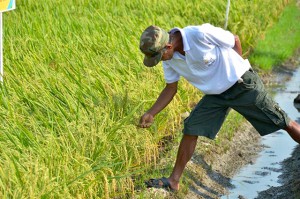To identify appropriate varieties with wider or location-specific adaptation, the project titled Accelerating the development and adoption of next-generation (Next Gen) rice varieties for major ecosystem in the Philippines conducted the initial participatory varietal selection (PVS) in selected sites across 16 regions of the country. 
PVS entries were composed of new varieties developed under the DA’s Rice Self-sufficiency Program implemented in 2009 to 2013 and serving as start-up materials in the new Food Staples Sufficiency Program under Next Gen.
Next Gen aims to use recent advances in plant breeding and improved computational power to make the country’s rice breeding program more efficient.
PVS is part of Next Gen’s component 2 that aims to accelerate the adoption of high-yielding rice varieties through a new multi-environment testing strategy and production of high quality seeds.
“Through PVS, yield trials in farmers’ fields will help them see how improved varieties perform in their area,” said Thelma F. Padolina, senior fellow at PhilRice.
In the recent assessment and planning workshop held in Subic, Zambales on 7-11 June 2015, Next Gen identified the preferred varieties by the farmers after 131 seed kits were deployed across 16 regions in 2014 wet season.
Out of the 86 trials established, 63 sites have valid data and were then analyzed by Next Gen researchers.
According to Dr. Mary Jean Du of the International Rice Research institute (IRRI), after analyzing data from regional clusters 1, 2 and 3 (composed of Luzon and Visayas regions), the most stable varieties across sites are the following: NSIC Rc302, inbred variety for irrigated lowland; RAELINE 3 for rainfed and drought; PSB Rc68 for submergence; and NSIC Rc330 for saline.
In regional cluster 4 (Mindanao), Du reported that the most stable varieties across sites are the following: NSIC Rc300 (performed best in Lanao Del Norte and Zamboanga Sibugay), NSIC Rc222 and NSIC Rc298 (performed best in Bukidnon and Misamis Oriental) for irrigated lowland; NSIC Rc192 and NSIC Rc348 for rainfed; NSIC Rc226 for saline; and PR40146 for submergence.
Varieties RAELINE 3 and PR40146, however, have not been released commercially.
Preference analysis and sensory evaluation of PVS test entries and field day activities were done as observed during monitoring visits of the Next Gen team to different PVS sites in 16 regions.
The Next Gen project is an initiative under the Food Staples Sufficiency Program of DA being implemented jointly with PhilRice and IRRI in partnership with UP Los Baños, DA RFOs, Bureau of Plant Industry, state colleges and universities, LGUs and rice farmers.




